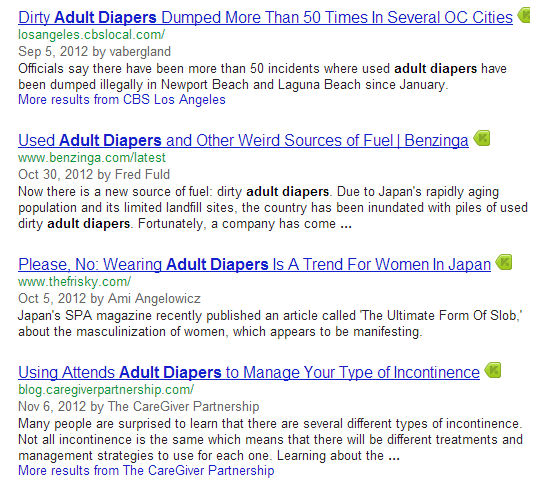In my last Copyblogger article, I talked about how to build an agile content marketing team. This time around, I’m going to focus on how to determine the potential size and reach of your content marketing opportunity.
One way to accomplish this is to see if readers are already displaying a passion for your space. Are they looking for the type of content you’re producing, or want to produce? Are they sharing it? If you create the right content, is there evidence that they would be willing to do so?
Don’t leap to early conclusions just because you think your space is not sexy.
Consider Seventh Generation’s Facebook page. They make household cleaners, laundry detergent, baby care, and personal care products. Yet their Facebook page has more than 1 million likes and almost 60,000 people talking about it. Those are serious numbers.
So, let’s dig in and do the research. How can you determine the reach of your content marketing opportunity?
I’ve listed eight specific steps below to help you do just that …
1. Use a keyword tool to get search volume info
Start doing searches on keywords and phrases that are relevant to your business goals.
The idea at this stage is to simply to get some idea of how many people are searching for your type of stuff. You’ll want to try different types and combinations of phrases. There are many great tools for this kind of work. One that I often use is the Google AdWords Keyword Tool:

With results from the keyword search volume data, you now have an estimate of just how often people are actually searching for topics related to yours.
Filter this information with your own knowledge of how likely these types of searches will move towards your conversion goals, or begin an ongoing audience relationship with someone that may become a customer at a later date.
2. Brainstorm targets in a conference room
In my eyes, this is one of the most overlooked steps in digital marketing today — simply putting your people in a conference room and brainstorming.
We all want to rush to our favorite search engine and/or social networking site and ask them to give us answers.
Don’t do that first.
The reason I insist on this is that effective critical thinking is what differentiates success and failure in this world. You want to exercise that brain of yours (and that of your team) every chance you can get.
If you are an expert in your niche, brainstorming with real people first is — in my opinion — absolutely the right way to go.
3. Develop a list of other sites publishing related content
Once you have an idea of the keywords for your space, go expand your search on some of them.
Make sure you place those key phrases in double quotes “” so you’ll get a refined list of sites publishing related content. Here is a sample search for “adult diapers” in Google Blog Search:

Fascinating, wouldn’t you say? You never know what you will learn when working on any given article … but, I digress.
Note that for many types of searches, the results may be highly commercial. For this exercise, we want to find the people publishing related content, so you may need to append some modifiers to see what you want.
For example, if you are in the machine tools space, you might want to search on machine tools blog (without the quotes):

Make a list of the sites you see as your content competitors in your niche. These are blogs or content-centric areas of web sites that are publishing related content.
4. Go to the other search engine
Now, head over to Bing and repeat the same searches (same goes for you Bing devotees, repeat your searches in Google).
This step is invaluable, simply because diferent search engines return different results. Doubling up can help add some bulk to your list:

In the example search I show here, only the first result is the same. This diversity continues as you comb further through the search results.
Use the other search engines (whichever it is for you) to increase the size and depth of your list.
5. Go get readership numbers
For those sites with RSS feeds, you can get an estimate of their subscriber base. The easiest way to do this is with Google Reader.
First, use Google Reader to subscribe to the blog, and then select that feed. Then, select “View details and statistics” as shown here:

Once you make that selection, you’ll get a report that looks like this one.

Of course, people use many different tools to read RSS feeds, and Google Reader is just one of them. However, one decent sized blog put Google Reader’s share of their subscribers at 59% back in 2009. That is probably a tad high, but even so, we can stipulate that the share of market for Google Reader is still very significant.
Use this data judiciously, and know that there are many other readers, but it will give you some feeling for readership.
There are also traffic tools out there that can help you see what traffic is going to given web sites. Some of these include Compete.com, Quantcast, Alexa. Here is a look at traffic stats on Alexa:

Numbers from these tools are crude at best, as they are based on a small sample size of total web traffic, but they still should give you a general sense of the traffic to the site.
6. Find the large audiences on Facebook
Start doing some queries using Facebook Search to find the more active sources of the type of content you’re producing:

You should click through and visit the individual pages so you can collect data on how many people are “talking about this” to get (what I consider) the most interesting numbers. This will enable you to get a sense for your ability to reach an audience beyond your direct fans.
Then take the search a bit further and try other variants such as “mechanical engineering,” if that makes sense for your business.
You can also try searching Facebook groups:

Last, but not least, see if a search with your favorite search engine turns up different results:

As Bing has a direct data feed from Facebook, they may be the best source of data for this type of information. In addition to the differentiated data, you can also see which of your friends know something about the topic on their social sidebar.
7. Find the large audiences on Twitter
Now it’s time to repeat the same exercise using Twitter Search.
Here’s a search on the hashtag: #furniture:

You can try this as a non-hashtag search as well, or play with Twitter’s Advanced Search to see if you can get better results.
8. Sum up the social media analysis
Another way to get at this data, for both Facebook and Twitter, is to go back to all the sites you brainstormed and found in your earlier research, and see what their feeds look like.
After all, if they’re big on publishing content to their site or blog, chances are many of them also do some serious social networking too.
Of course, there are other significant social media sites, but the point of this analysis is to get a rough sizing of the opportunity, so you can decide how to invest in the strategies your content marketing team is working on.
Don’t ignore the other social sites entirely, just spot check them to see if they are active in your space.
Later, when you actually launch your content marketing effort, other sites may become large players in it, but seeing what’s happening on Facebook and Twitter should get you the info you need to begin.
The key thing to focus on is not the number of Followers or Fans, but instead on the interactivity. That’s the true multiple here.
People who initially become your Followers or Fans are probably not the ones you’re trying to reach. They already know about you! The payoff is when they tweet/retweet/share your stuff, because they’ll be exposing you to their audiences. That’s where things start getting interesting in social.
Cool, but what now?
After all this analysis, you now should have a good idea of what your competitors are doing in the space, how they are investing, and what your options are.
Here are four thoughts on how to process all the data you’ve collected:
1. Assess the Unique Advantages You Have
What platforms would they best work on? How does that match up with the audience you are trying to reach? Is competition already there? How will you differentiate? What level of effort will it take to succeed? These questions are a part of understanding what advantages you may have in approaching your content marketing strategy.
2. Consider the Potential Payoff
Are you looking to drive direct conversions? Build your brand by creating high levels of viaibility and showing your expertise? This is a key step in sizing the investment you want to make. Also, seeing how your competition is doing helps you decide how large a benefit you can get.
3. Decide on an Investment Focus
Now that you’ve scoped out — in detail — what others are doing, start thinking about the best way for you to engage in your social media strategy. Here are some questions to ask along those lines:
- Will you have a blog on your own site?
- How much high end guest posting will you be doing? Note that I consider it a given that you will do this at some level.
- Do you want to allow guest writing on your blog?
- What social networking sites will you be active in?
- How much effort will you put into social networking vs. writing?
- What role will giving interviews play in your strategy?
- How many conferences / speaking engagements will you (your company) be involved in?
You should put a lot of weight on what your content marketing team can actually pull off. Your subject matter expert (SME) may have some strong preferences, and that is a key part of the puzzle.
4. Decide on an Investment Level
This is where you have to do some math that is specific to your business.
Your research will have shown you what the competition is doing. You know what your budget restrictions are (or should be able to find that out). Now you need to make a call, but with the information you’ve gathered, you should be able to make a decision on how aggressive you want to be.
Good luck!

Reader Comments (30)
This is a very detailed instruction on determining content marketing opportunity, thank you.I consider checking necessary results using different search engines to be very important and helpful, so you can get better view how saturated your niche is.
Thank you for you post, again, very comprehensive.
This is excellent information if anyone was thinking of getting into a new niche or just trying to make money online I am going to be pointing them to this post. This really lays out the step by steps and the time that is really required to look, weigh, and determine what’s best.
You not only ask the right questions, you answer them as well in this post. I honestly, have never thought about using Google reader as tool to help analysis, but I think after read this it’s a no brainer to that extra step and look into that one.
Lastly, I will admit you have to have a plan and ask the right questions such as you suggest like:
What platforms would they best work on?
Is competition already there?
And than ask how will this payoff, or how I am going to to maek it pay off?
Excellent post,
Eric
As I always say, people are looking for answers to their questions on the web. You have to know how big that audience is and how big your competition is. But in all honesty, this is not only about content marketing. It’s true for the total eCommerce being.
Eric, this well explained i like the idea of guest posting on high end blogs but the only problem is the acceptance and attitude of so called influential bloggers within our niches. Personally i think we should write high end guest post on our sites so as to tilt the scale of the influntial bloggers, then after that we can go ahead and pitch our geust post. What do you think about that Eric?
Hi Bill – each niche is different, but you are right that a key part of the process is to figure out how to develop trust with the target influencer. That often involves posting great content on your site for a while first. Other ideas:
* Pitch conferences for speaking engagements. This is a great credibility builder.
* Pitch blogs or sites that are not in your vertical, but that do cover your vertical. They may be more receptive early on to your article ideas.
* Offer to interview influencers in your vertical. This can be quite an effective way to break ice with someone.
They key is to make the commitment to solving the problem and do what it takes to get there!
Good information. These are all good things to be doing as you look to plan any marketing strategy.
Great tips on what’s poised to be a great opportunity online over the next few years. If content really is king – as they say – the people who stand to benefit the most are those who can qualify audiences and opportunities in order to provide content that stands out and gets noticed. The strategy you’ve outlined here will go a long way towards helping people do that!
Also, thanks for the tip on looking up subscriber stats via Google Reader – can’t believe I haven’t seen that before! I’m definitely going to use that to help qualify guest post opportunities in the future
Unbelievable timing! I was just about to sit down to check out the size of the market for a new copywriting training product we’ve got in mind. Serendipity…
Okay, this makes the well so much deeper than I thought it was. Just when I think there must be an easier way to do something – someone (like you) writes an article that says, basically. It’s not. Rats.
Being of the lazy, no account sort, I am tempted to follow Wendy’s (as in hamburgers) and just look where McDonalds’s (they do tons of research) builds their next franchise and build across the street.
Interesting idea! I checked a few of these steps when I was trying to collect some information for creating a blog. I didn’t thought that you can “theorize” them. I also thought about that tip with searching on Facebook, but I did’nt think it’ll have interesting results and I quit before starting. Now I’ll try!
Glad to see someone still champions people (interacting face-to-face) as a place to spark content ideas. I like that you used this article to reinforce the importance of metrics (whether this done by manual analysis or any number of online tools).
I also liked that you focused heavily on strategy at the end of the post. Depending on your audience social media should play a larger or smaller role in strategy (as should any part of your online marketing). I suggest asking “What social networking sites do you need/should you be active in?”
Thanks for the great post!!!
Marketing is no longer a game of demographics and statistics. It requires a true scientific approach. Too many people dump money and time into a plan without considering the metamorphosis our audiences have undergone in the past decade. Thanks for the great information. You invested a great deal of time here.
Thank you Eric, excellent post and excellent timing. We are currently working on all these strategies for our new e-commerce site. We certainly have some stiff competition so your ideas are a great help.
Cheers
Sue
Very informative and thorough post. Might take some time, though.
Excellent Info. This research is the kind of thing that can totally get my head spinning and intimidate me. You’ve made this understandable and doable. Thank you!
Awesome Article (as always) and a good timing. Started a new Business this year, and have a need for every little information…
Best Wishes from Germany
Max
Great post! Saving a lot of time using statistics from the Google Reader that I never cared to look at…
Thanks
This should serve as the basic planning tool to people who are outlining their website revenue startegies. Should give them a fair idea of competition, how to get ahead of it, and what to expect in return.
Very comprehensive and informative post, as usual.
Just when I think you guys can’t out-do yourselves any more with great, unique and useful information, you go and post something like this and I spend hours going through it, following your links and finding more resources than I ever would’ve found if you hadn’t opened my eyes.
At this rate, I am expecting a blog on how to print legal money at home to come very, very soon.
Nicely written as there is so much depth covered on this topic. One thing that I’ve learned over the years is that if you don’t know who and what you are dealing with, basically it means you are not getting anywhere. Not only on competitors but the size of market, what everyone is interested about, every small little detail needs to be analyzed and studied.
This is great. I’m going to use this as a frame of reference for future campaigns. Awesome.
The reason content marketing is getting a lot of attention is because it’s so effective. It builds brand value, it enhances an expert image, and it has proven very effective in lead generation to identify prospective customers.
Excellent article.
One possible addition: once you’ve determined what people are searching, check Amazon to see what they are actually buying.
This article's comments are closed.